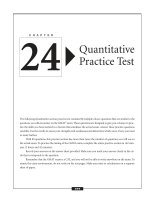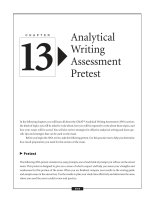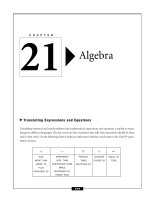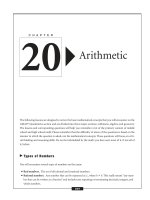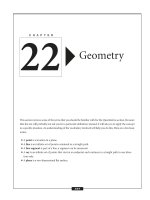Quantitative Pretest
Bạn đang xem bản rút gọn của tài liệu. Xem và tải ngay bản đầy đủ của tài liệu tại đây (116.6 KB, 10 trang )
The entire GMAT® quantitative part of the exam takes place in one section of the test. This section contains
37 questions and must be completed in 75 minutes. Therefore, the test taker can spend about two minutes
per question, on average. The questions in this section consist of two different multiple-choice formats: prob-
lem solving and data sufficiency. Each type of question has five possible choices for answers. These questions
test a person’s knowledge of mathematical concepts and their applications, along with thinking and reason-
ing skills. Examinees will be asked to recall the mathematics that they learned in middle school and high
school and apply these skills in an advanced manner for the questions on the test. Although scrap paper is
allowed, the use of calculators is prohibited on the GMAT exam.
Since the Quantitative section is only administered as a CAT, this section will be taken on a computer.
As each person takes the exam, the computer randomly generates the sequence of questions administered
based on the participant’s ability. The test begins with a question of average difficulty. If the question is
answered correctly, points are added to the score and a more difficult question follows. If the question is
answered incorrectly, there is no penalty, but an easier question follows. Keep in mind that harder questions
carry more weight and will result in a higher score. Because of the CAT format, each question must be
answered and confirmed before proceeding to the next question. Since randomly guessing an incorrect answer
CHAPTER
Quantitative
Pretest
18
307
will lower your score, making an educated guess by eliminating one or more of the answer choices should
result in a better score. Your score is based on both the number of questions you answer and the level of dif-
ficulty of the questions; the more difficult questions you answer, the better.
Even though the Quantitative section is administered on a computer, minimal computing skills are nec-
essary. Free GMAT tutorials can be downloaded from various Internet sites and taken ahead of time. The test-
ing site also offers a tutorial that can be completed immediately before commencing the test. These skills, such
as using the mouse and the HELP feature, should be practiced before beginning the test. Once you start a par-
ticular section of the exam, the clock cannot be stopped. Time spent asking for help will be counted in the
total time for that particular section.
The quantitative portion will not test how well you recall a lot of facts and figures; instead, it will test
how well you use your existing knowledge of math and how well you apply it to various situations. In addi-
tion, this section of the test will not evaluate your personality, work ethic, or ability to work with others.
Although the problems may seem difficult at times, they will not be assessing the undergraduate work you
may have completed in college or any particular course you may have taken; the math will be high school level.
Even though the test is used as a precursor for business school, the questions will not require knowledge of
business-related skills.
This section of the test contains a number of trial questions that are being field-tested for future use.
These particular questions will not be counted toward your total score; however, the actual questions are not
distinguished from the trial questions. Do your best on all of the questions and treat them as if they all count.
Problem Solving Questions
–
QUANTITATIVE PRETEST
–
308
1.abcde
2.abcde
3.abcde
4.abcde
5.abcde
6.abcde
7.abcde
8.abcde
9.abcde
10. a b c d e
11. a b c d e
12. a b c d e
13. a b c d e
14. a b c d e
15. a b c d e
16. a b c d e
17. a b c d e
18. a b c d e
19. a b c d e
20. a b c d e
ANSWER SHEET
Directions: Solve the problem and choose the letter indicating the best answer choice. The numbers used in
this section are real numbers. The figures used are drawn to scale and lie in a plane unless otherwise noted.
1. If both the length and the width of a rectangle are tripled, then the area of the rectangle is
a. two times larger.
b. three times larger.
c. five times larger.
d. six times larger.
e. nine times larger.
2. If a set of numbers consists of
ᎏ
1
4
ᎏ
and
ᎏ
1
6
ᎏ
, what number can be added to the set to make the average
(arithmetic mean) also equal to
ᎏ
1
4
ᎏ
?
a.
ᎏ
1
6
ᎏ
b.
ᎏ
1
5
ᎏ
c.
ᎏ
1
4
ᎏ
d.
ᎏ
1
3
ᎏ
e.
ᎏ
1
2
ᎏ
3. Given integers as the measurements of the sides of a triangle, what is the maximum perimeter of a tri-
angle where two of the sides measure 10 and 14?
a. 34
b. 38
c. 44
d. 47
e. 48
4. In 40 minutes, Diane walks 2.5 miles and Sue walks 1.5 miles. In miles per hour, how much faster is
Diane walking?
a. 1
b. 1.5
c. 2
d. 2.5
e. 3
5. If x Ϫ2, then
a. x Ϫ 2
b. x Ϫ 10
c. 5x + 2
d. x + 2
e. 5x Ϫ 2
6. If five less than y is six more than x + 1, then by how much is x less than y?
a. 6
b. 7
c. 10
d. 11
e. 12
5x
2
Ϫ 20
5x ϩ 10
ϭ
–
QUANTITATIVE PRETEST
–
309
7. If x dozen eggs cost y dollars, what is the cost, C,ofz dozen eggs?
a. C ϭ xyz
b.
c.
d. C ϭ xy + z
e. C ϭ x + y + z
8. At a certain high school, 638 students are taking biology this year. Last year 580 students took biology.
Which of the following statements is NOT true?
a. There was a 10% increase in students taking biology.
b. There were 90% more students taking biology last year.
c. There were 10% fewer students taking biology last year.
d. The number of students taking biology this year is 110% of the number from last year.
e. The number of students taking biology last year was about 91% of the students taking biology
this year.
9. Two positive integers differ by 7. The sum of their squares is 169. Find the larger integer.
a. 4
b. 5
c. 9
d. 12
e. 14
10. Quadrilateral WXYZ has diagonals that bisect each other. Which of the following could describe this
quadrilateral?
I. parallelogram
II. rhombus
III. isosceles trapezoid
a. I only
b. I and II only
c. I and III only
d. II and III only
e. I, II, and III
Data Sufficiency Questions
Directions: Each of the following problems contains a question that is followed by two statements. Select your
answer using the data in statement (1) and statement (2) and determine whether they provide enough infor-
C ϭ
yz
x
C ϭ
xy
z
–
QUANTITATIVE PRETEST
–
310
mation to answer the initial question. If you are asked for the value of a quantity, the information is suffi-
cient when it is possible to determine only one value for the quantity. The five possible answer choices are as
follows:
a. Statement (1), BY ITSELF, will suffice to solve the problem, but NOT statement (2) by itself.
b. Statement (2), BY ITSELF, will suffice to solve the problem, but NOT statement (1) by itself.
c. The problem can be solved using statement (1) and statement (2) TOGETHER, but not ONLY
statement (1) or statement (2).
d. The problem can be solved using EITHER statement (1) only or statement (2) only.
e. The problem CANNOT be solved using statement (1) and statement (2) TOGETHER.
The numbers used are real numbers. If a figure accompanies a question, the figure will be drawn to scale
according to the original question or information, but it will not necessarily be consistent with the infor-
mation given in statements (1) and (2).
11. Is k even?
(1) k + 1 is odd.
(2) k + 2 is even.
12. Is quadrilateral ABCD a rectangle?
(1) m ∠ ABC ϭ 90
°
(2) AB ϭ CD
13. Sam has a total of 33 nickels and dimes in his pocket. How many dimes does he have?
(1) There are more than 30 nickels.
(2) He has a total of $1.75 in his pocket.
14. If x is a nonzero integer, is x positive?
(1) x
2
is positive.
(2) x
3
is positive.
15. The area of a triangle is 36 square units. What is the height?
(1) The area of a similar triangle is 48 square units.
(2) The base of the triangle is half the height.
16. What is the value of x?
(1) x
2
ϭϪ6x Ϫ 9
(2) 2y Ϫ x ϭ 10
–
QUANTITATIVE PRETEST
–
311




